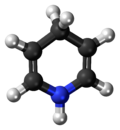| |||
| Names | |||
|---|---|---|---|
| Preferred IUPAC name 1,4-Dihydropyridine [1] | |||
| Identifiers | |||
3D model (JSmol) | |||
| ChemSpider | |||
| MeSH | 1,4-dihydropyridine | ||
PubChem CID | |||
| UNII | |||
CompTox Dashboard (EPA) | |||
| |||
| |||
| Properties | |||
| C 5H 7N | |||
| Molar mass | 81.1158 g mol−1 | ||
Except where otherwise noted, data are given for materials in their standard state (at 25 °C [77 °F], 100 kPa). | |||
1,4-Dihydropyridine (DHP) is an organic compound with the formula CH2(CH=CH)2NH. The parent compound is uncommon, [2] but derivatives of 1,4-dihydropyridine are important commercially and biologically. The pervasive cofactors NADH and NADPH are derivatives of 1,4-dihydropyridine. Dihydropyridine calcium channel blockers are a class of L-type calcium channel blockers used in the treatment of hypertension. 1,2-Dihydropyridines are also known. [3] [4]


